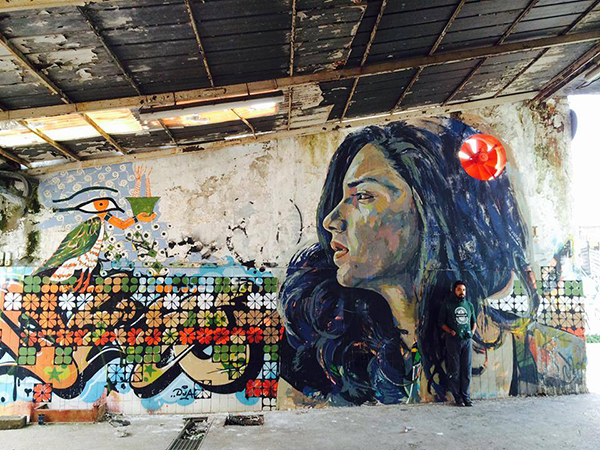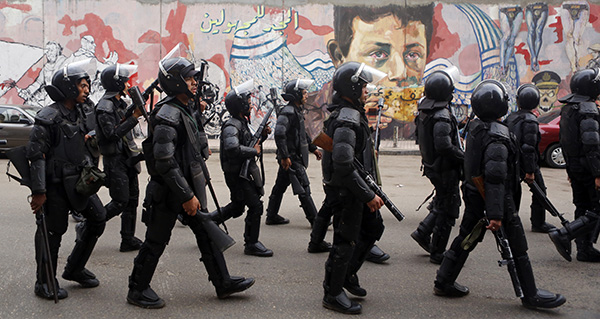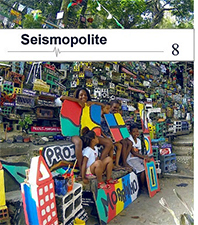Dec.10, 2014
Suspending Freedom: Image Politics and
propaganda in Egypt
Written by Basma Hamdy
In order to control a nation that had already toppled two presidents in the course of three years and to firmly establish his position as Egypt’s one true leader, President Abdel Fatah El-Sisi approached governance with a classic authoritarian approach: establish a condition of fear, silence opposition voices and disseminate favorable images of the regime and its institutions.[1] Paul Virilo argues in The Administration of Fear that: “states are tempted to create policies for the orchestration and management of fear…they have to convince citizens that they can ensure their physical safety”.[2] Thus, constantly comparing the future of Egypt to that of Syria and Iraq established a deep fear among Egyptians leading them to almost yearn for the country’s pre-revolution condition. In discussing image politics, Lina Khatib associates authoritarian states in the Middle East with Lefebvre’s “terrorist society” in which “violence is always latent”. In this state, a systematic dissemination of terror is necessary to maintain obedience.[3]
Controlling the “three institutional components of the deep state: the military, the ministry of the interior, and the General Intelligence Service”, which have been under public scrutiny during the course of the revolution, would enable Sisi to control the country in a way his predecessors had not achieved.[4] A series of limiting laws and declarations were issued which allowed for such control, such as formalizing the role of the army, expanding its authority as well as the role of military courts. The series of laws included a protest law, which prohibits any public assembly of more than ten people without government approval. Mass arrests, jail terms and military trials ensued and fed a cycle of bureaucratic terror. In her article Authoritarianism and its Adversaries, Jill Crystal argues: “once force is used regularly, huge if mundane new bureaucracies of terror emerge to sustain it: political police, intelligence officers, censors, thugs.”[5]
This enabled the state to tighten its grip on dissent and reinforce its exceptional policies. Crystal refers to this as ‘developmentalism’ which is the “the belief that the state must play the central role in promoting economic growth and that, to that end, individuals and social organizations must relinquish power to it, allowing it the routine if temporary use of force against enemies.”[6]

In addition to controlling the deep state, the media would be another primary area of focus for the regime. As Khatib points out: “for authoritarian states political control means having control over visual production.”[7] As a result, Orwellian state-sponsored advertorials and patriotic songs that were praising state institutions and condemning terror spread dramatically. These were tinged with nationalist nostalgia and pop-culture in order to influence the Egyptian masses. In Ambiguities of Domination Lisa Wedeen explains the importance of “successful rhetoric and symbols [in order to] produce legitimacy, charisma or hegemony for the regime.”[8] This is particularly evident in the building of Sisi’s cult of personality when he is compared with former Nationalist Egyptian President Gamal Abdel Nasser in order to evoke memories of a “collective glory”. Most media and newspaper outlets were overwhelmingly perpetuating a singular view. This was clearly articulated following the Sinai attacks of October 24th when the editors of seventeen independent and state-owned newspapers signed a statement of allegiance supporting the government in its war on terror and pledging not to criticize state institutions.”[9] As Crystal argues, “At the heart of developmentalism is the idea that the deprivation of certain political rights is both necessary and temporary and that only a coercive state can promote the economic growth that will eventually sustain political freedom or render it unimportant.”[10]
In addition to the dissemination of images that were favorable to the regime it was also necessary to suppress those that were not. Censorship in Egypt does not follow a clear or transparent mechanism. For example, when popular talk show host Bassem Youssef’s popular satire show was cancelled in June 2014 he stated that the show “doesn’t have a space [and isn’t] allowed.” However, he did not clearly define how he arrived at that conclusion. A direct censorship may produce public solidarity but indirect and inconsistent censorship can confuse and distract. In an article in Time.com, Rasha Abdulla, a professor of journalism and mass communication at The American University in Cairo, states that “the pressure is never official, all you need is a phone call or a word in passing. We don’t know the exact mechanism, but it’s happening, and the results are very clear.”[11] This inconsistent mechanism of censorship became blatant when two popular talk show hosts were pulled off the air within a few days of each other: Wael al-Ibrashy on Dream TV and Ibrahim Saad on Al-Nahar TV. Another example was when Belal Fadl, a popular journalist, was not allowed to publish his weekly article in Al-Shorouk newspaper.[12] This unpredictable and pliable form of censorship is not different from Mubarak’s strategy, as explained by Mark Allen Peterson in his online blog: Connected in Cairo: “Part of the genius of the regime is that the laws have been inconsistently enforced. No journalist, blogger or social scientist knows when the police may show up because they’ve crossed an invisible line. This encourages cautious self-censorship.”[13] The silencing of critical voices is not only a product of the state; but is also possible because of the “interference of third parties who seek for themselves an authority as censors.”[14] These third parties file lawsuits, write articles and make public statements condemning persons who criticize the regime. This is also true of heads of TV channels and newspapers who may impose censorship and administer pressure on their employees in order produce regime-friendly material. Naturally, celebrities associated with the revolution are heavily attacked since their sweeping influence is a threat to the regime. In addition to Bassem Youssef and Belal Fadl, other targeted celebrities include Yosri Fouda, Amr Waked, Khaled Aboul Naga and Reem Maged. The lawsuits and statements against them range from calls to have them arrested, to have their tongues chopped off or even tried for homosexual tendencies.
Undoubtedly, the control of image production would extend to visual artists who are at the forefront of the visual revolution since they created work that resonated deeply with Egyptians and attracted worldwide attention. In May 2014, shortly before Sisi was sworn in as president a number of artists, including Ganzeer --who was one of the most prominent artistic voices of the Egyptian Revolution-- were accused of being affiliated with the Muslim Brotherhood organization. The presenter, Osama Kamal, was speaking on a privately owned TV network closely associated with the regime. Kamal called to have the artists arrested following the publication of an article in the Guardian which discussed their initiative to create anti-Sisi works along with other international artists. Ganzeer reacted by publishing a response titled: “Who’s afraid of Art” on his blog in which he demanded a public apology from Kamal and called for the termination of his show.
Ramy Essam, is another prominent activist and artist targeted for his views. Essam was hailed as the singer of the Revolution and his song Erhal (leave) became its anthem. Arrested and tortured by the military in March 2011, he became a national hero and created songs that were wildly popular among Egyptians. Both Ganzeer and Essam are no longer living in Egypt, and while this is a temporary arrangement it remains a growing concern that many young revolutionaries are now leaving. Essam states in his interview in Free Muse: “My songs are being censored by state media. I have been harassed by individual policemen and interrogated by National Security Police.”[15]
Despite the arrests, jail terms and human rights violations, opposition voices are still strong and resilient. Artists, writers, journalists and musicians continue to produce work that challenges the regime and its followers. From Sweden, Ramy Essam produced a music video that sardonically uses footage from the famous pro-regime song Bushret Kheir (A Good Omen), which was composed by Amr Moustafa, who is considered Feloul (supporter of the ex-regime) and highly supportive of Sisi. The song named “In the Age of the Pimp” criticizes the President and Egypt’s current state of affairs and is inspired by the social-network hashtag “vote for the pimp” which was popular during the Sisi/Sabbahi elections. A verse from the song reads:
“He makes our people homeless in Sinai and the media have become prostitutes
our brothers in prison are piles of flesh and the pimp rules appropriately.”
Ganzeer’s most recent works critiquing the Egyptian military is a series of posters titled: “Of Course the Army has Protected the Revolution”. The posters created in 2013 layer the words from the title with portraits of famous victims who were attacked or killed by the military during its rule over Egypt. They serve as a reminder of military atrocities against civilians and are an ironic answer to the propagated statement that the military --led by Sisi-- had actually saved the revolution from the Muslim Brotherhood. Ammar Abo Bakr also recently created murals in solidarity with Sanaa Seif who was arrested on June 21st 2014 for her role in a demonstration against the controversial protest law. Seif is the youngest of three siblings who are all prominent activists and the daughter of famed, and recently deceased, human rights lawyer Ahmed Seif El-Islam.

Amidst the growing human rights violations and attacks on freedom, a haunting image speaks for itself. It was captured on the third anniversary of the clashes of November 19th 2011 when security forces walked along the symbolic Mohamed Mahmoud Street in heavily armed uniforms, carrying automatic weapons. Amidst their blackness is an image of young martyr, Sayed Khaled, a homeless street child who was painted by Ammar Abo Bakr a year earlier. On November 29th 2014 Mubarak, his sons and cronies were acquitted of all crimes and the nation watched in shock as the man responsible for 30 years of corruption walked free. Sayed Khaled, the unknown street child appears to be staring out in defiance, he is a reminder of the many young lives lost in the quest for freedom and the many young futures destroyed as a result of corruption, poor healthcare and education. The phrase painted next to him reads: “glory to those who are unknown.”
Basma Hamdy is an Egyptian artist, designer, and educator who has been teaching art and design in the Middle East for 10 years. She graduated from the American University in Cairo in 1998 and completed an MFA from the Maryland Institute College of Art (MICA) in 2003. She is co-editor of Walls of Freedom: Street Art of the Egyptian Revolution (2014), a comprehensive book that documents the street art movement in Egypt.
[1] Khatib P. 7
[2] Virilo.
[3] Ibid.
[4] Springborg.
[5] Crystal p.282
[6] Ibid.
[7] Khatib p. 1
[8] Wedeen p. 5
[9] Abdel Kouddous.
[10] Crystal p. 283
[11] Malsin.
[12] Belal.
[13] Allen Peterson.
[14] Jacquemond.
[15] http://freemuse.org/archives/8301
Bibliography
Abdel Kouddous, S. (2014, October 28). Egypt’s 1984. Retrieved November 24, 2014, from http://carnegieendowment.org/sada/index.cfm?fa=show&article=57051&solr_hilite=
Allen Peterson, M. (n.d.). Censorship. Retrieved from http://connectedincairo.com/egypt-rising-up/why-revolution/censorship/
Belal Fadl censored in Shorouk, publishes in Mada Masr. (2014, February 3). Egypt Independent. Retrieved November 30, 2014.
Crystal, J. (n.d.). Authoritarianism and its Adversaries in the Arab World. World Politics, Vol. 46, No. 2. (Jan 1994) 262-289.
Egyptian singer Ramy Essam: “Why I move to Sweden for two years”. (2014, October 24). Free Muse. Retrieved November 25, 2014, from http://freemuse.org/archives/8301 Fayed, H. (2014, November 17).
Prominent actor sued, attacked in media for calling Sisi a ‘failure’. Retrieved November 30, 2014, from http://thecairopost.com/news/129142/news/actor-sued-called-unmasculine-for-labeling-sisi-a-failure
Ganzeer. (May 2014). Who’s Afraid of Art? Retrieved from http://www.ganzeer.com/post/85826356062/whos-afraid-of-art
Jacquemond, R. (2014). The Shifting Limits of the Sayable in Egyptian Fiction".MIT Online Journal of Middle East Studies,Vol. IV.
Khatib, L. (2013). Image politics in the Middle East: The role of the visual in political struggle. London: I.B. Tauris.
Kingsley, P. (2014, May 8). Graffiti artists unite against Egypt's presidential hopeful Abdel Fatah al-Sisi. Retrieved October 18, 2014, from http://www.theguardian.com/world/2014/may/08/graffiti-artists-unite-against-abdel-fatah-al-sisi-egypt
Malsin, J. (2014, June 3). Bassem Youssef Abruptly Cancels Egyptian Satire Show Before Sisi Declared President. Retrieved November 19, 2014, from http://time.com/2818306/bassem-youssef-abruptly-cancels-egyptian-satire-show-before-sisi-declared-president/
Sawiris responds to media persecution of Yosri Fouda. (2014, June 26). Retrieved November 30, 2014, from http://www.madamasr.com/news/sawiris-responds-media-persecution-yosri-fouda
Springborg, R. (2014, March 26). Abdul Fattah al-Sisi: New face of Egypt's old guard. Retrieved November 27, 2014, from http://www.bbc.com/news/world-middle-east-26188023
Wedeen, L. (1999). Ambiguities of domination: Politics, rhetoric, and symbols in contemporary Syria. Chicago: University of Chicago Press.









